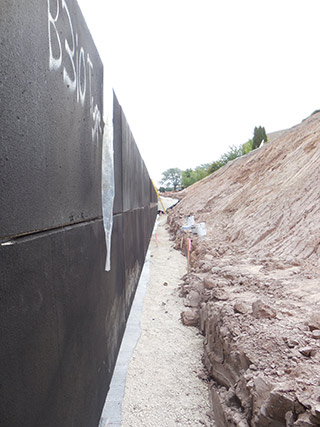With a history of water problems, the city of Appleton, Wis., faced a deluge of difficulties. Residential and commercial property owners were very concerned about flooding on their land. Storm water didn’t stop there; it was even impacting local emergency response units and their ability to navigate the city. The city council needed an innovative solution. Midwest Industrial Coatings promised to deliver.
“The council was
brainstorming ideas, but nothing seemed foolproof,” recalled Peter Bakke,
operations manager at Midwest Industrial. “The necessary structure required an
expansive area of land. Eventually, the decision was made to put a below-grade
retention basin underground to avoid goose migration and, consequently,
mosquitoes on such a large plot of property.”
Location,
Location, Location
After kicking around several site
alternatives, the local high school was considered. The city decided to install
an 88,000-square-foot (8,175.5 m²) storm water retention system under two high
school parking lots. The area offered the necessary amount of land and the
project could be completed while the school was closed over two consecutive
summers. From the last day of school to the last
day of summer, the plan was to excavate, install, and backfill the system and
then asphalt the parking lots.
While a sound decision,
it was not without complications.
“The proposed location
for the system was adjacent to a well, so it needed to be below the water table
to make sure ground water couldn’t enter and impact drinking water,” Bakke
explained. “There were a lot of component pieces, so we had to add joints. The
design included storm traps, and the council feared their biggest potential
problem would be if they weren’t watertight. We stepped up to plate and said
‘We can make this happen.’”
A woman-owned,
Wisconsin-based business, Midwest Industrial started in 2003 and now employs
about 10 people. The company works in all 48 continental states; this project
was close to home.
First and Down
A three-person crew was assigned to the
two-phase Appleton job. Phase 1 took place in
spring and summer of 2013 and Phase 2 occurred in 2014. The first step: The
crew tested and designed the waterproofing system.
Phase 1 officially began
when 150 precast StormTrap units, which each weighed 28,000 pounds (12,700.6 kg),
were delivered from Illinois to Midwest’s Waukesha, Wis.,
facility. Midwest rented a Manitou forklift
with a 45,000-pound (20,411.7 kg) capacity to handle each heavy precast piece.
To accommodate a fast-paced
June start time, the crew verified that all the units met the spec and then
began the pre-coating process. They used a Graco NXT Xtreme Pump to apply
Perlastic by Global Polymer Solutions, a cold-applied liquid asphalt emulsion
waterproofing system.
“We unloaded stages in
our laydown yard,” Bakke said. “We sprayed all the pieces between April and
Memorial Day, and then coordinated delivery by reloading the pieces on
semi-flatbed tractor services that we’d contracted to begin installation in the
high school parking lot.”
 At the site, the crew
applied CETCO WATERSTOP-RX 101 to seal the joints. A Bentonite Sheet Membrane
Dual Waterproofing System, which is designed for use on backfilled walls, was
also used underneath the precast StormTrap units to prevent water from passing
through. Finally, an average thickness of 80 mils (2,032.0 microns) each of
Perlastic spray grade (SG), roller grade (RG), and trowel grade (TG) were
applied over the entire exterior surface.
At the site, the crew
applied CETCO WATERSTOP-RX 101 to seal the joints. A Bentonite Sheet Membrane
Dual Waterproofing System, which is designed for use on backfilled walls, was
also used underneath the precast StormTrap units to prevent water from passing
through. Finally, an average thickness of 80 mils (2,032.0 microns) each of
Perlastic spray grade (SG), roller grade (RG), and trowel grade (TG) were
applied over the entire exterior surface.
“Because of the depth of the
units, which were installed 20 feet [6.1 m] below ground, we had to go
underground to apply the coating,” explained
Bakke. “The other contractors were
backfilling and burying right behind us as we were working.”
To ensure crew members’
safety, Midwest set-up a perimeter safety line
to demarcate the area. The crew wore harnesses, Tyvek suits, 3M eye and hearing
protection, respirators, and high-visibility vests.
Let It Rain
One year later, for Phase 2, the crew
repeated the process and pre-coated 180 pieces for the second structure, which
would connect to the first to successfully store the storm water runoff.
The second phase was met
with more challenges. For starters, this project was twice the size as the
first one. Add to that, the summer of 2014 brought excessive amounts of rain — 110
inches (279.4 cm) — and high humidity, which hindered application of the
moisture-cured coating.
Because they used
high-pressure spray systems, controlling the product overspray at a large high
school with many summer activities presented a problem for any passersby. So,
the crew applied coatings in the early morning (from 6 a.m. to 10 a.m.) and
late evenings (from 6 p.m. to 10 p.m.) to accommodate setting pieces, traffic
on the site, as well as the high temperatures and humidity.
But that’s not all. A
great deal of road construction in the area limited access. And because of high
water table conditions, the crew had to constantly pump water out of the area.
Teamwork
Prevails
Every person on the crew alternated doing different
tasks to get the job done in 18 weeks, sometimes working seven days in a row — and
nights. The coating was complete on time and ready for backfill.
“This is a top-notch team
and because of their hard work, the project was a success in the end despite
any hurdles we faced,” said
Bakke. “Without this coating and waterproofing
solution, the project would have never happened.”